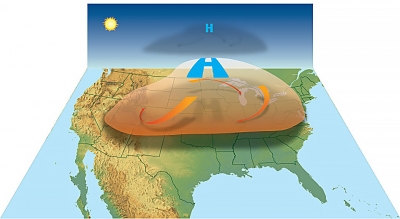
Europe recently experienced an intense heatwave resulting in record temperatures owing to the creation of a heat dome. But what is a heat dome? Come, let’s find out.
A high-pressure system hovering in the atmosphere over Europe trapped the heat in a phenomenon called “heat dome”. This weather phenomenon begins when there is a strong change in ocean temperatures.
Imagine a overhead water tank in summer. As the heat rises, the water in the tank turns warm but the moisture and steam cannot escape due to the tank lid. Similarly, a heat dome occurs when the atmosphere traps a mass of hot ocean air like a lid or cap over an area in dry summer conditions.
When this hot air attempts to escape, the high pressure in the atmosphere pushes it down. Under the dome, the air unable to escape sinks and compresses, releasing even more heat. Besides, it also blocks other weather systems from moving in. This leads to an increase in temperatures at ground level. So people, crops, and other living beings under it suffer terribly.
According to scientists, heat domes are linked to the behaviour of the jet stream, a band of strong winds high in the atmosphere that generally runs from west to east. “Normally, the jet stream has a wavelike pattern, meandering north and then south and then north again. When these meanders in the jet stream become bigger, they move slower and can become stationary. That’s when heat domes can occur.”
This dome of hot air can stretch over vast regions and last for days together, leading to extreme temperatures and the formation of a relentless heatwave. The hotter the temperature the stronger the heat dome gets.
This stagnant weather pattern usually leads to weak winds and a rise in humidity. Heat domes can badly affect us, raising the risk of heat illnesses and deaths as people would not be able to cool down properly.
Picture Credit : Google




